
Malaya Konyushennaya Street is a pedestrian street in the historical center of St. Petersburg.
Malaya Konyushennaya Street is not stretched, its length is 350 meters.
The street runs parallel Bolshaya Konyushennaya Street and Griboyedov Canal. Stretches from Swedish Lane to Nevsky Prospekt (opposite Kazan Cathedral) is one of the most visited and beautiful streets of the city.
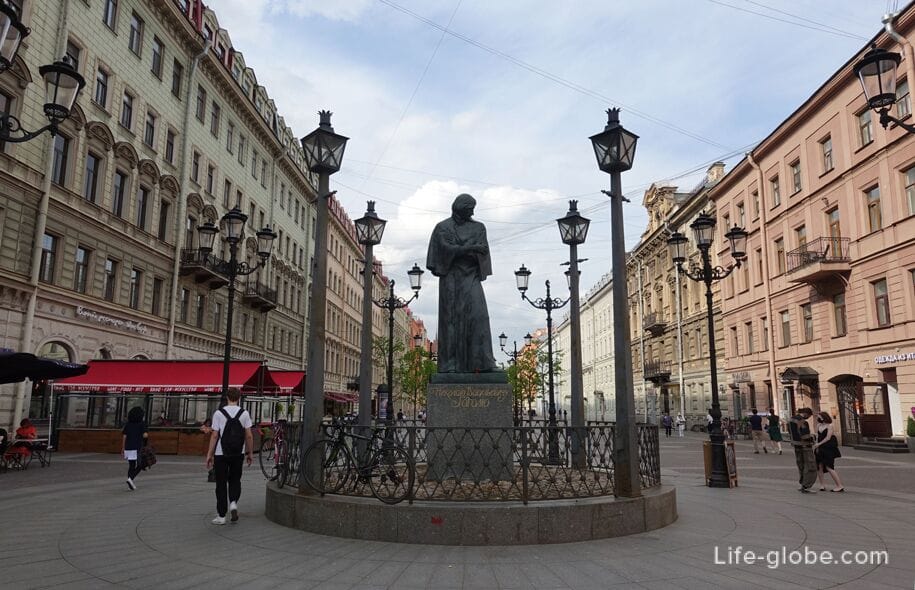
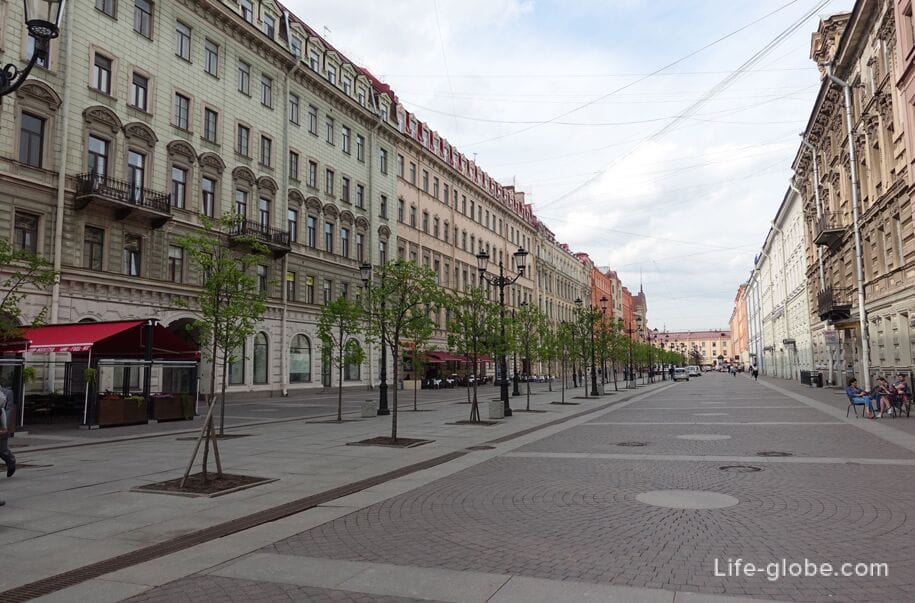
The street was formed in the 1730s according to the plan of the Commission on the St. Petersburg structure created by Empress Anna Ioannovna. The laying of the street was included in the general plan for the construction of the Court Stables (Stable Yard), erected in 1720-1723 near the present Konyushennaya Square. According to the Stable Yard, the street, in 1776, received its name "Konyushennaya"; before that, the street was called "Bolshaya Rozhestvenskaya".
Today Malaya Konyushennaya Street is completely pedestrian and is located in the Central District of St. Petersburg.
Along the street, on both sides, there are historical buildings, in which there are, among others, the Zoshchenko Museum, the Lutheran church, shops, cafes and restaurants with tables in the open air.
The street is also decorated with trees, lanterns, a historical weather pavilion and monuments.
Thanks to all this, Malaya Konyushennaya Street is one of the most attractive in St. Petersburg for walking and recreation, both among local residents and guests of the city.
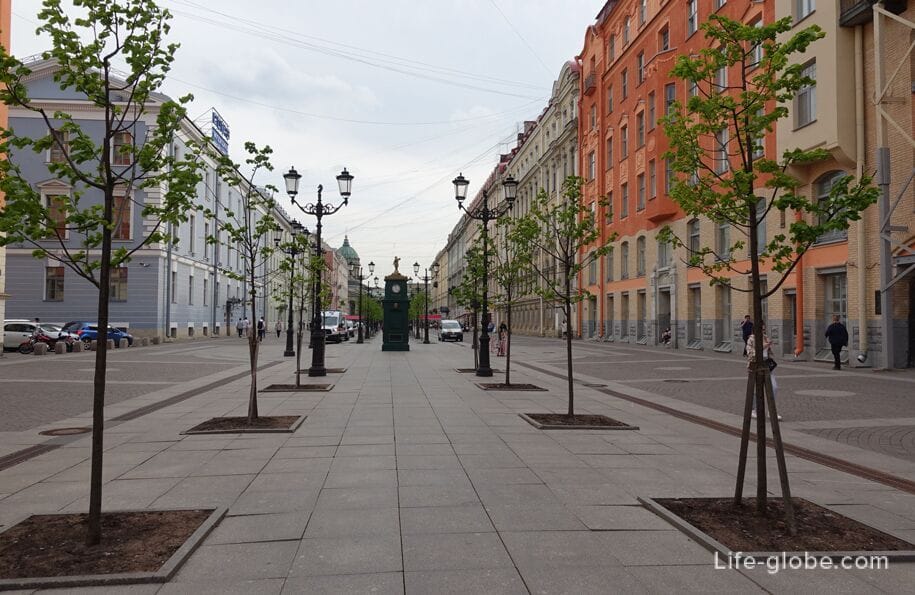
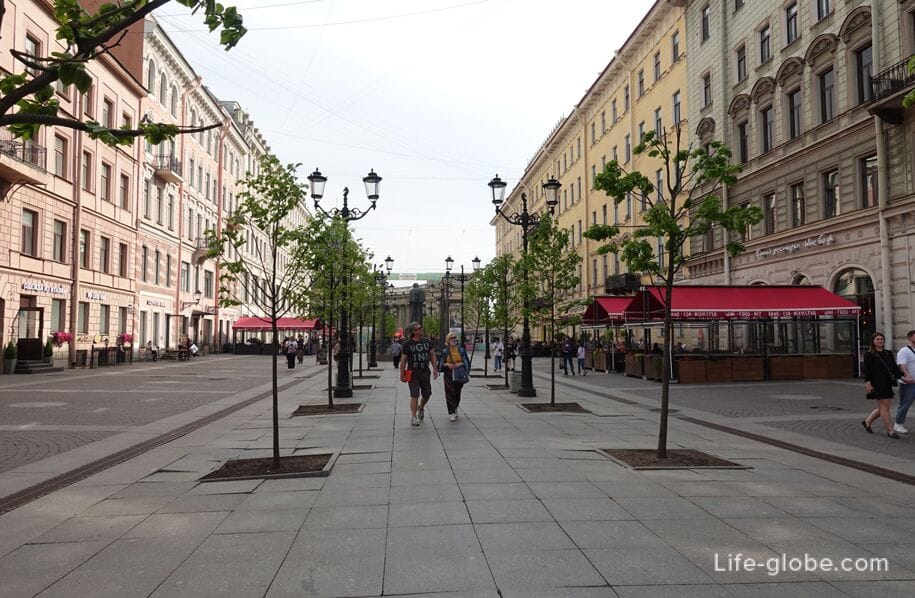
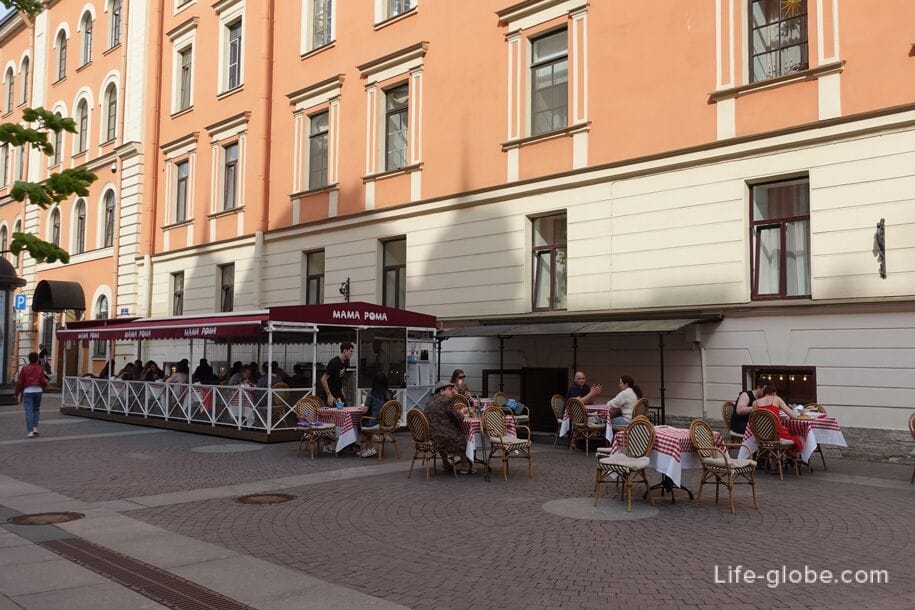
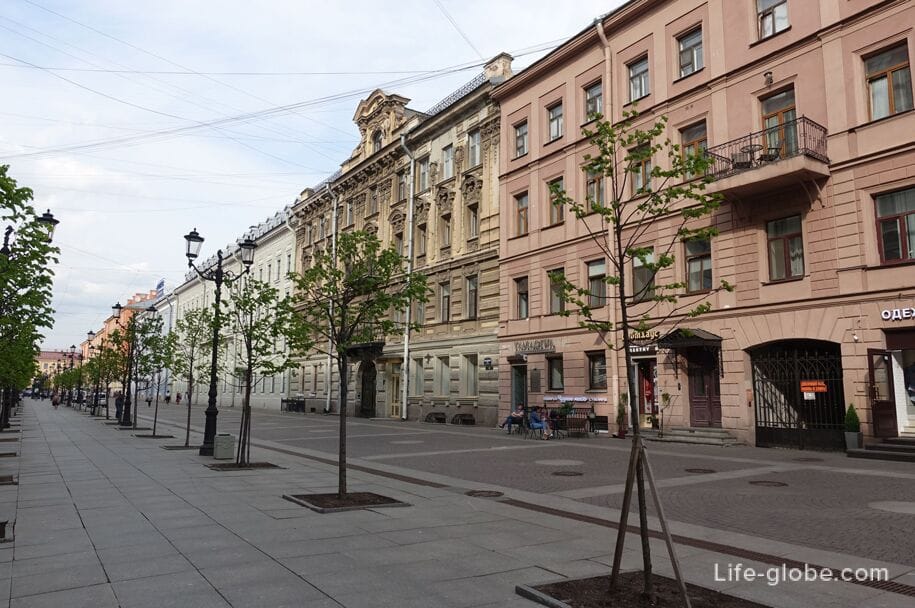
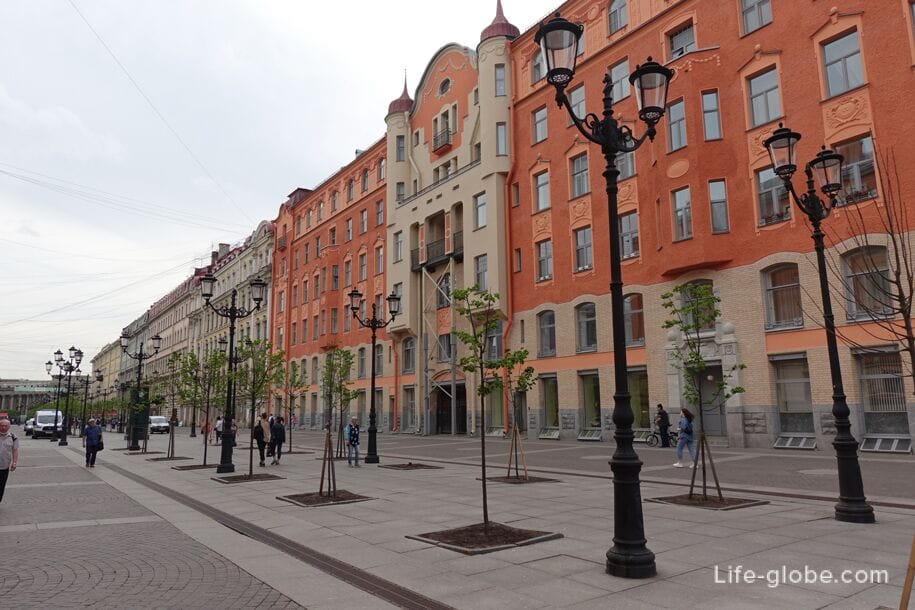

A bronze monument to Nikolai Vasilyevich Gogol is installed on Malaya Konyushennaya Street near Nevsky Prospekt.
The monument was made by sculptor Mikhail Vladimirovich Belov and architect Vladimir Sergeevich Vasilkovsky. Opened on December 8, 1997.
The monument is mounted on a high pedestal and fenced with an artistic low lattice with four lanterns.
Nikolai Vasilyevich is depicted in a standing closed pose with a thoughtful look.
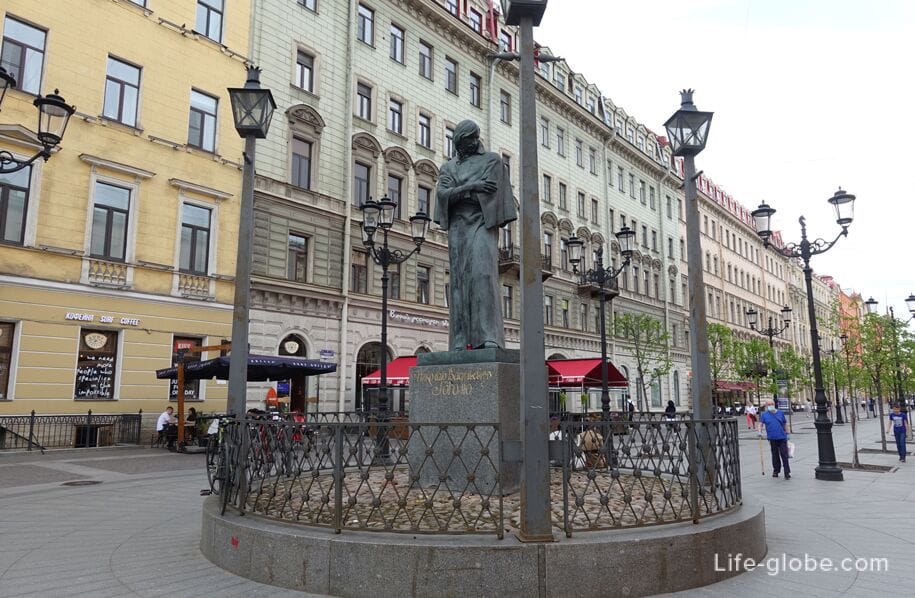
Corner building at the address: Malaya Konyushennaya Street, 16 / Nevsky Prospekt, 26 - Hansen House.
The Hansen House was first built in 1776-1777 for the camera-courier Colonel P.P. Trunov.
Subsequently, the building changed owners. The house housed retail establishments, and 20 apartments were arranged.
In 1873-1874, the architect V.A. Kenel, the house was completely rebuilt by order of the new owner - the Norwegian entrepreneur G.I. Hansen. The building has become a five-storey building with an eclectic facade. Yard outbuildings were also built. It was one of the first buildings in St. Petersburg with storefronts at a height of two floors. The first two floors were intended for shops and offices, the other three were rented out.
In 1912, architect Karl Karlovich Schmidt changed the decoration of the facades of the two lower floors, redesigned their interiors.
Today, this corner building, fronting Nevsky Prospekt and Malaya Konyushennaya Street, still has large windows on the 1st and 2nd floors and multiple architectural details of decoration.

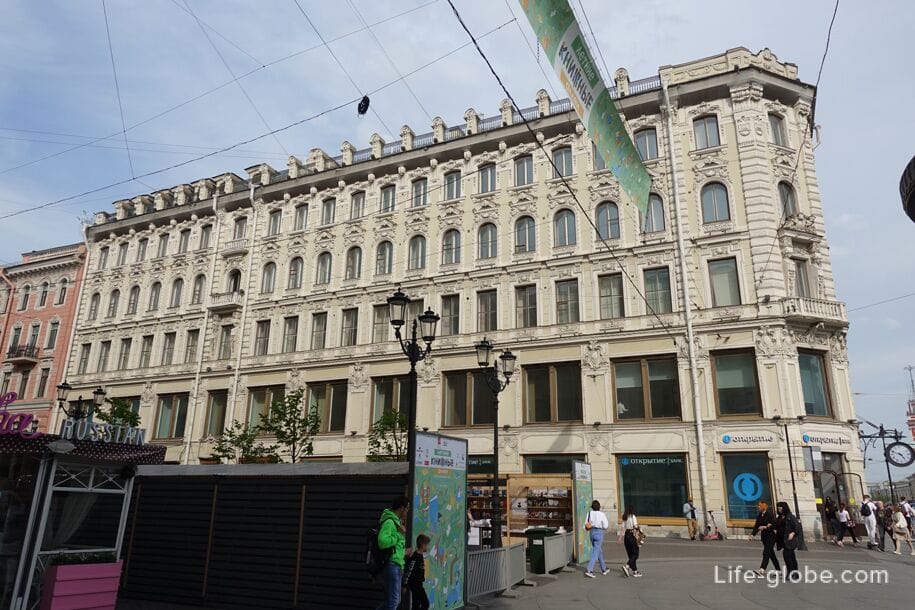
Corner building at the address: Malaya Konyushennaya Street, 9 / Nevsky Prospekt, 24 - the house of the German Lutheran Church of St. Peter (Peterskirche).
The house was originally built in 1735; it was wooden and had one and a half floors.
In 1747-1752, according to the project of architect I.G. Kempf, a new stone building was built on the site of a wooden house.
In 1830-1832, architect E.T. Zollikofer rebuilt the house into a profitable three-storey stone house in the style of classicism.
In 1910-1911, the building was built on two floors. The superstructure was designed by architect V.E. Collins.
The simple decoration of the facades of houses with an even grid of windows includes cornices, rustication, balusters and sandricks of the second floor, as well as rare balconies. More about the Peterskirche and the house...

View of the building from Nevsky Prospekt

An elegant and bright building, made in the eclectic style with decorations and rare balconies.
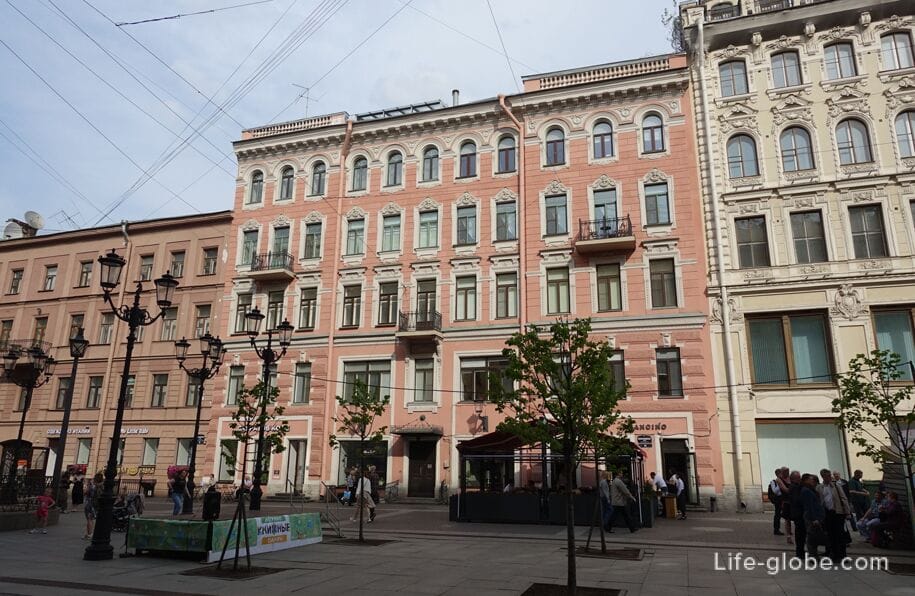
The building was built in 1849-1850 by architects N.P. Grebenka and Lange August Ivanovich for K. Welsh.
The building is designed in an eclectic style and does not have a rich finish.
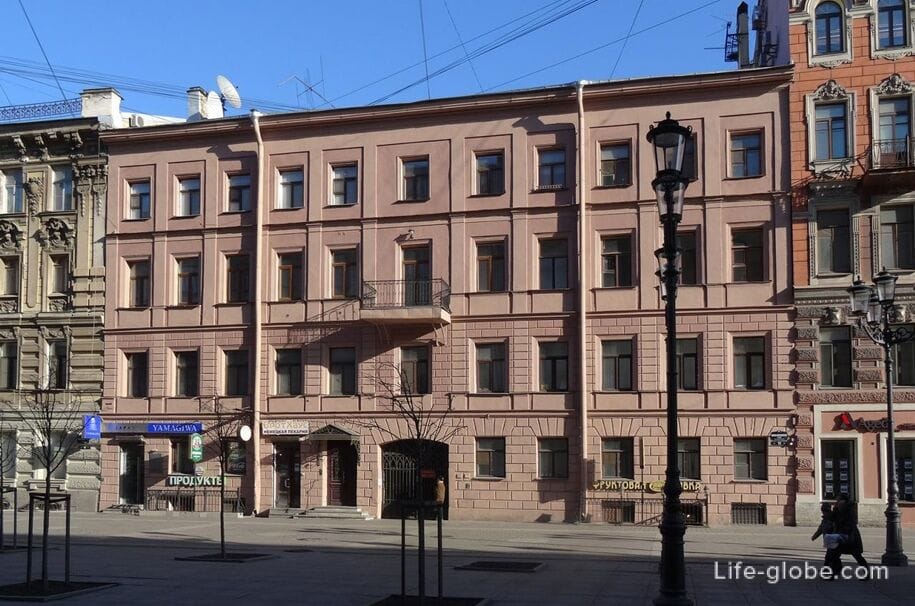
The building was built as an apartment building of the German Lutheran Church of St. Peter in 1859-1860 by architect A.H. Pele.
Initially, the house was four-storeyed. The fifth floor and the attic were built in 1913 by architect W.E. Collins.
The building has an eclectic style.
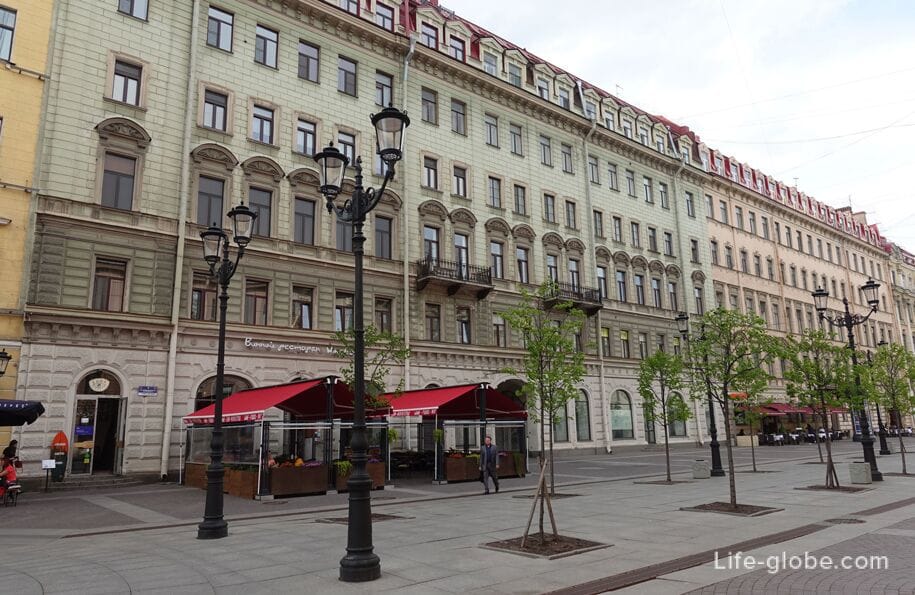
The building consists of two houses built in the late 18th and early 19th centuries, and then rebuilt and built over.
The left part was the home of the German Lutheran Church of St. Peter, and in the right part was the women's department of the Petrishule.
The left part has an eclectic style, the right - neo-baroque.
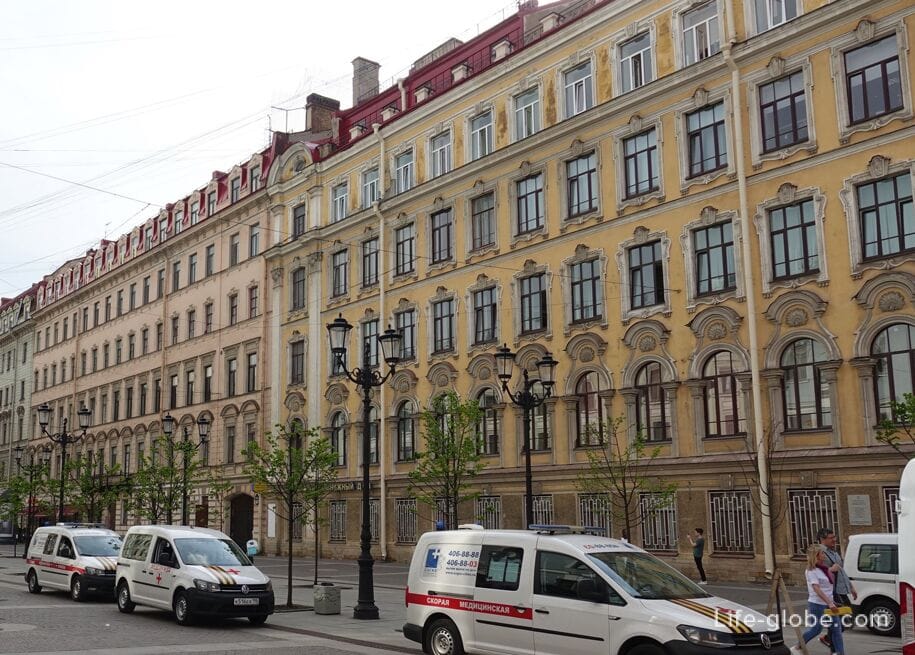
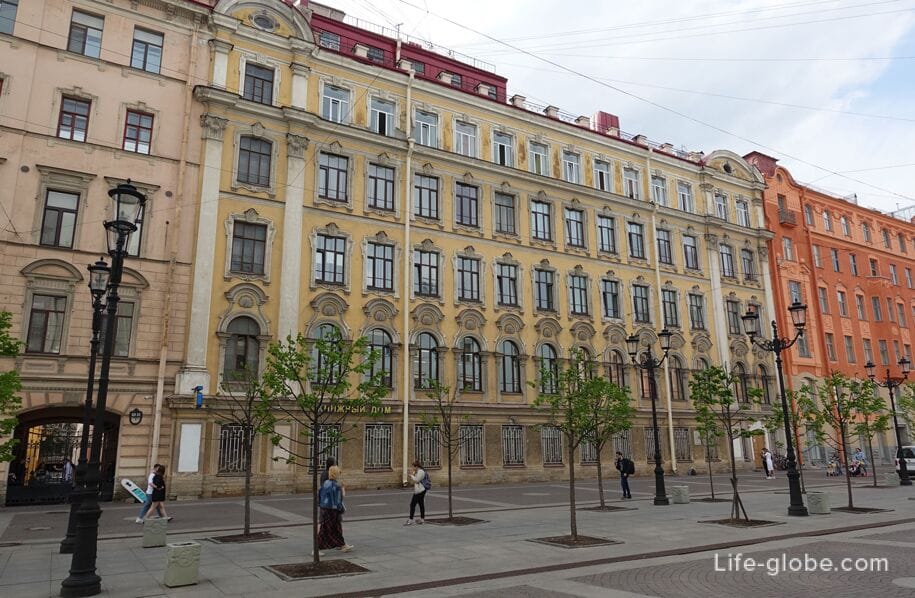
The building was built in the first half of the 19th century and belonged to K.I. Treason.
It was rebuilt in 1875 by architect Pavel Yulievich Soyuzor.
The building is designed in the eclectic style.

It was one of the most famous fashion houses in St. Petersburg, which employed 60 dressmakers.
Today, the building houses an International Medical Center.
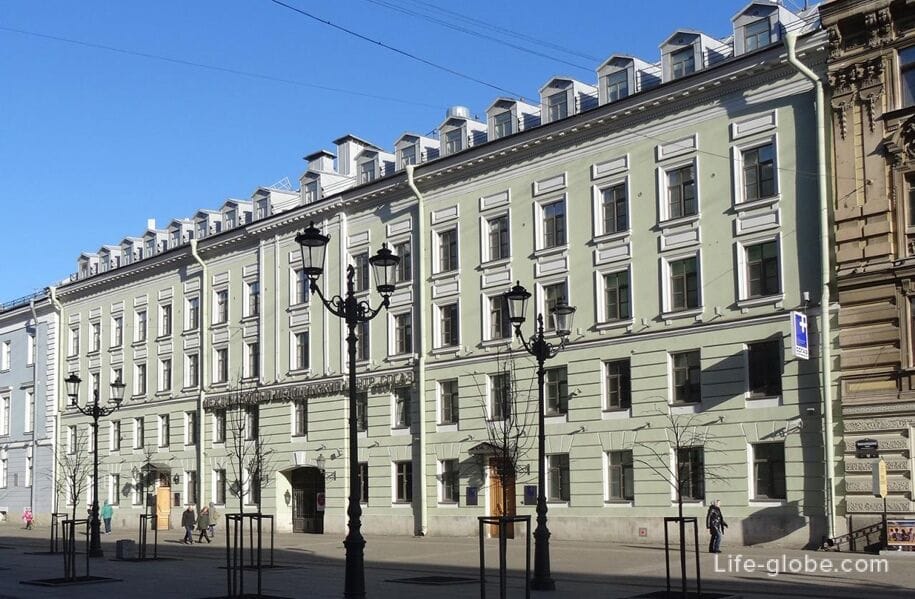
The building of the Court Hospital was erected in 1846-1857 by the architect Roman Ivanovich Kuzmin. In the future, the building was rebuilt.
The hospital was intended to treat the ranks of all institutions of the Ministry of the Imperial Court, including the ranks of the Grand ducal houses.
This is a corner building facing Malaya Konyushennaya Street, 6 and Cheboksary Lane, 1.

On Malaya Konyushennaya Street, in the alignment of Cheboksary Lane, there is a historical "Weather Pavilion".
Initially, the meteorological pavilion on Malaya Konyushennaya Street was designed by architect Nikolai Evgenievich Lancere. The ball pavilion was made in 1913 by order of the City Council of St. Petersburg. In 1914, the pavilion was installed on Malaya Konyushennaya Street at the intersection with Nevsky Prospekt.
The pavilion was a small meteorological station that recorded atmospheric pressure and air temperature using a barograph and a thermograph, and also kept a chronology of changes using recorders. Precise instruments required constant supervision: the drum was wound up with a key for a day, turned, and a measurement curve was drawn on a special tape. Through the showcases of the pavilion, it was possible to get acquainted with the weekly recordings of the readings of the recorders.
Based on the results of processing weather information received by telegraph from the European part of Russia and Western Europe, a Synoptic map was created and a weather forecast for the day was given.
Sculptor Vasily Vasilyevich Kuznetsov worked on the sculptural models made of cast iron decorating the pavilion. Gilded figures in antique style, framing the pavilion clock, symbolize Time. The clock faces are mounted on all four sides of the structure. The pavilion is crowned by the figure of a Newt blowing a conch shell. Keystones with masks are fixed under the cornice under the clock.
In the 1930s, the pavilion was dismantled and moved to Elagin Island and the Kirov Central Park of Culture and Recreation, where it stood in an abandoned state for about 70 years. Over time, the barograph with the recorders disappeared from the pavilion, and the clock mechanisms failed.
The pavilion was partially restored and returned to Malaya Konyushennaya Street in 1997. One of the initiators of the pavilion transfer was Alexey Nikolaevich Lancere, the son of the creator of the ancient weather station.
In the fall of 2018, the facade of the pavilion was renovated, and the clock mechanisms were replaced with more modern ones. Today, according to the Lancer clock on the pavilion, you can check the exact time again.
A barograph made in 1954 by the Safonov plant "Gidrometpribor" is presented in the showcase of the pavilion.
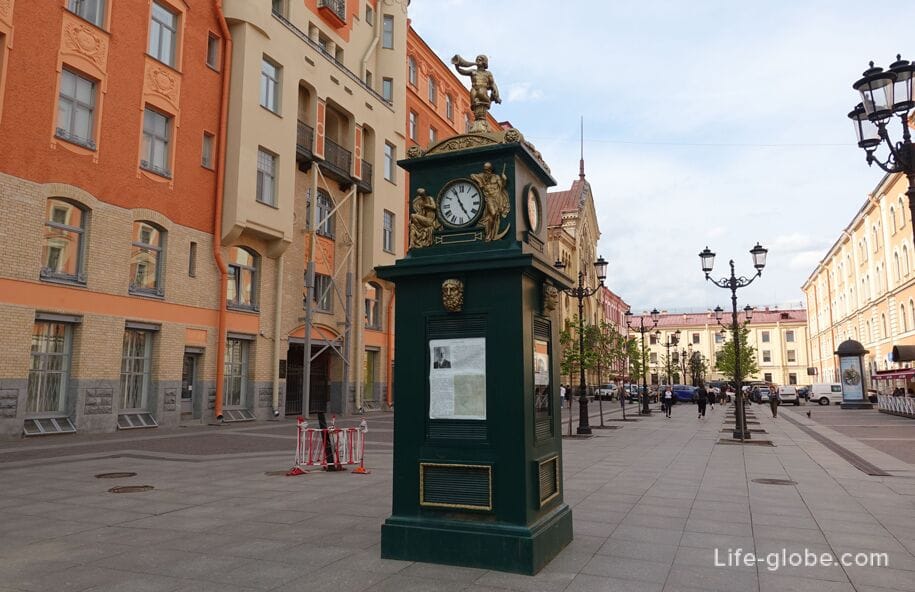
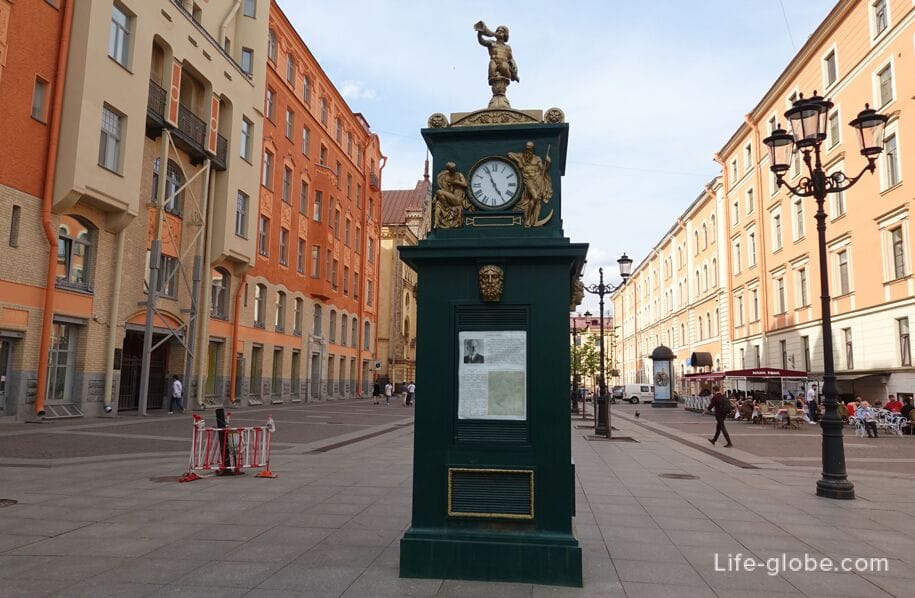
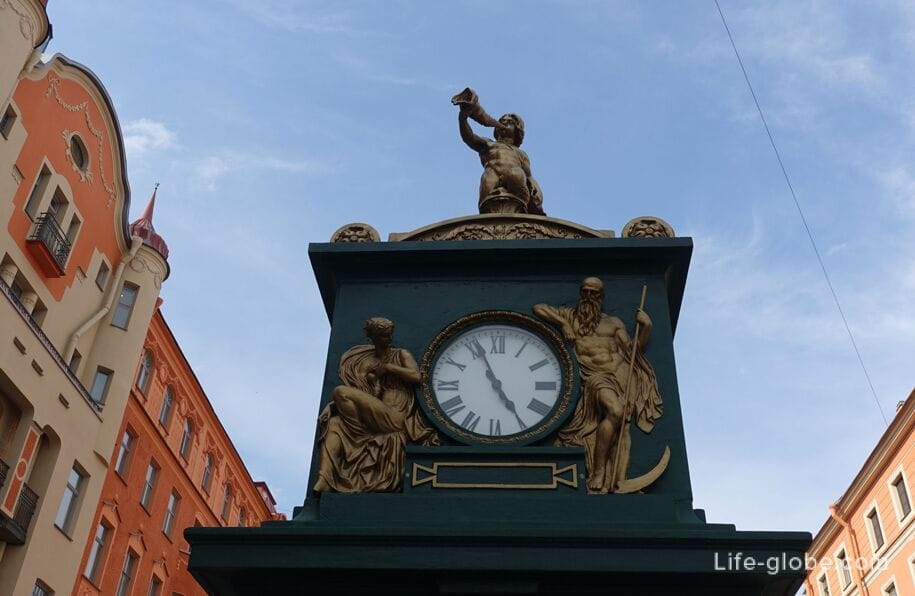
The residential building of the Evangelical Swedish Church of St. Catherine was built in 1823-1862 by architect Karl Karlovich Anderson.
It was rebuilt in 1904-1905 by architect Fyodor Ivanovich Lidval.
The architecture of the building combines modernist motifs with classical techniques of constructing a composition - a symmetrical three-part one.
Smooth and textured plaster of different colors, facing light yellow glazed tiles were used in the processing of the facade.
Turrets, small bay windows and rare balconies are visible in the facade decorations.
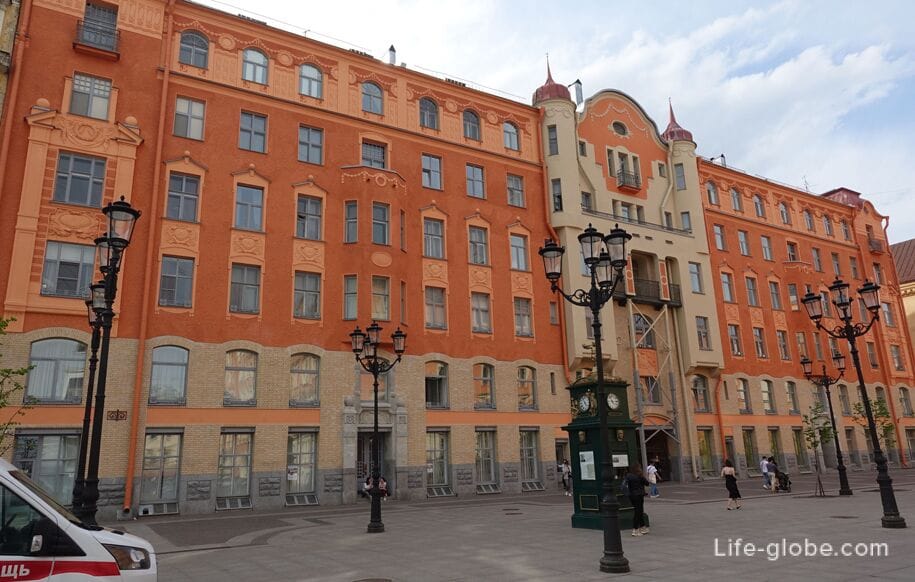
The Swedish Lutheran-Evangelical Church of St. Catherine dates back to 1767.
In 1734, Empress Anna Ioannovna presented the community with a plot in the area of modern Nevsky Prospekt, on which the first wooden church in the name of St. Anna was built. In 1745, the Swedish and Finnish communities separated. The Finnish community remained in the same place - now it is located there The Finnish Church of St. Mary (address: Bolshaya Konyushennaya Street 8a), and the Swedes built a prayer building in a new place (Malaya Konyushennaya Street), where in 1767-1769 the stone church of St. Catherine was erected according to the project of architect Y.M. Felten.
During the history of the church was rebuilt. At the church there was a parish school, shelters for boys and girls, an almshouse, a charitable institution.
Today it is the Evangelical Reformed Church "Way, Truth and Life". Services are held in the church.
The building is made in pseudo-Romanesque style with a rose window.
St. Catherine's Church website: refspb.

Corner building at the address: Malaya Konyushennaya Street, 1 / Swedish Lane, 1 - the former house of the Swedish Church.
The Swedish Church House was built in 1781 for the nearby St. Catherine's Church. Rebuilt in 1863-1865 by architect K.K. Anderson.
Architect F.I. Lidval studied at the church school in the 1870s.
Since 1997, the Consulate General of Sweden has been located within the walls of the building.
The building looks simple. The facades are treated with blades and panels, small teeth and an arcature.
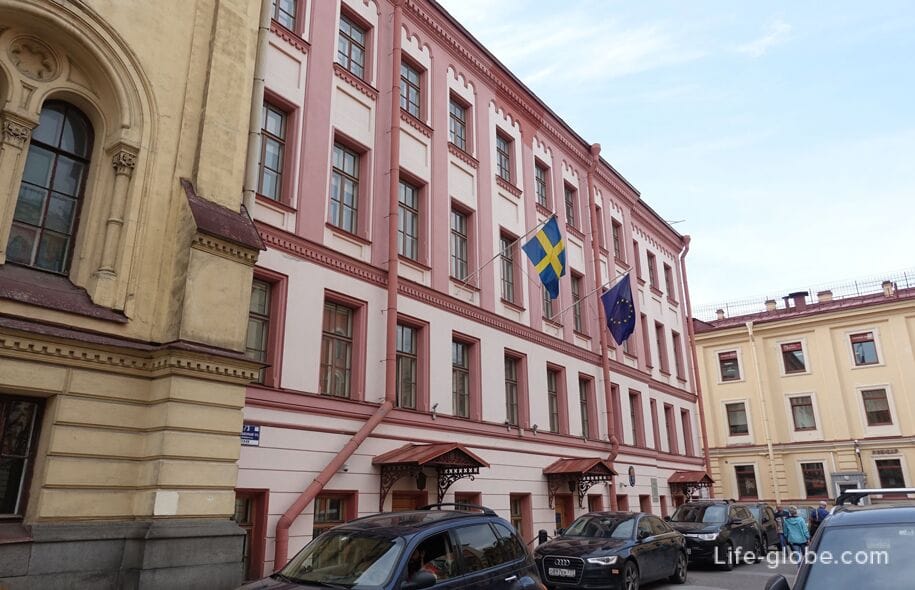
The complex of buildings of the Court Stable Department (residential building) has existed since the middle of the 18th century.
During the history of the building was rebuilt and built up.
The artists of the court orchestra lived in the building. After the revolution of 1917, the writers' housing cooperative was located, for which the house was built on two floors.
The building is designed in the classical style.
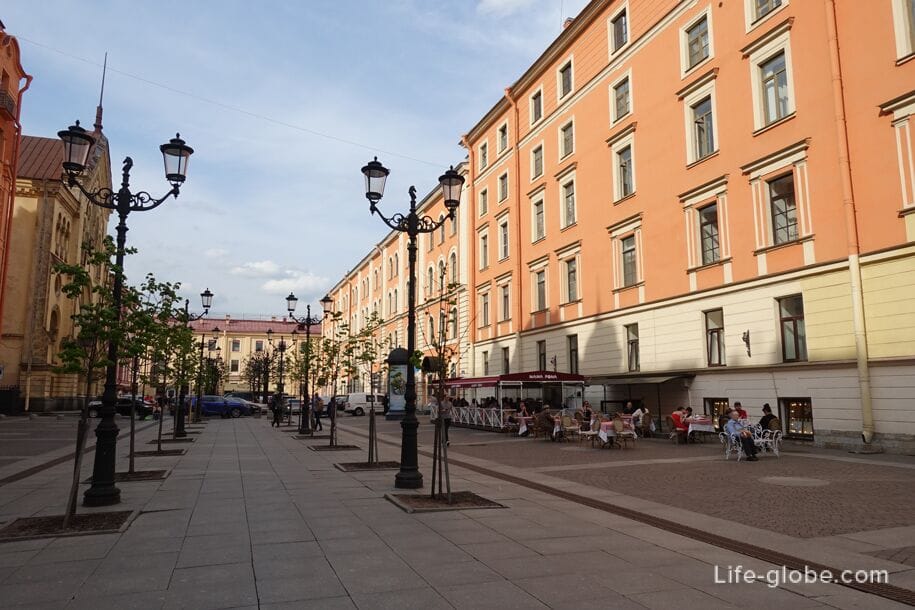
The writer Mikhail Mikhailovich Zoshchenko lived and worked in this house in 1934-1941 and 1945-1958. In 1992, a museum-apartment of M.M. Zoshchenko was opened in one of the apartments of the house, which still exists today.
A visit to the museum is paid. Entrance to the arch from Cheboksary lane, apartment 119.The museum's website: museum-xxvek.ru/ekskursii-mk-zoshhenko .
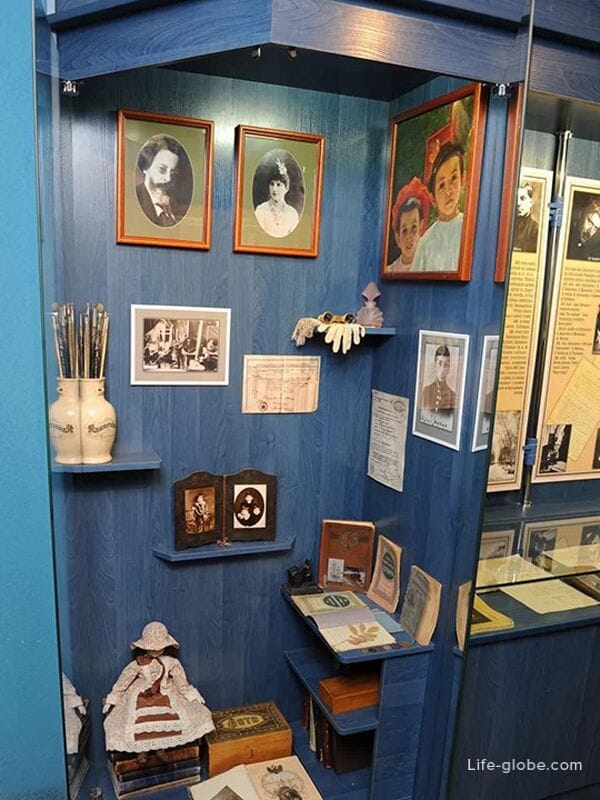
The hospital of the Court and Stable Department was built in 1840 by architect Alexander Ivanovich Bourgeois.
The building has an eclectic style.
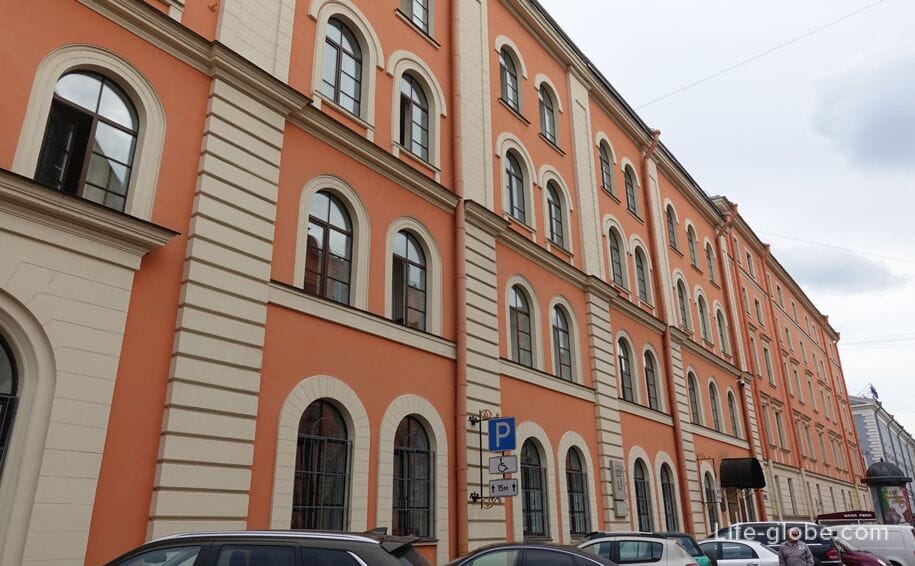
There is an honorary memorial plaque on the wall of the building, which preserves the memory of the great Pskov and Leningrad architect-restorer Yuri Pavlovich Spegalsky (1909-1969).
The inscription on the board reads: "In this house from 1948 to 1968 lived an architect, artist, restorer, the largest researcher of ancient Pskov Yuri Pavlovich Spegalsky."
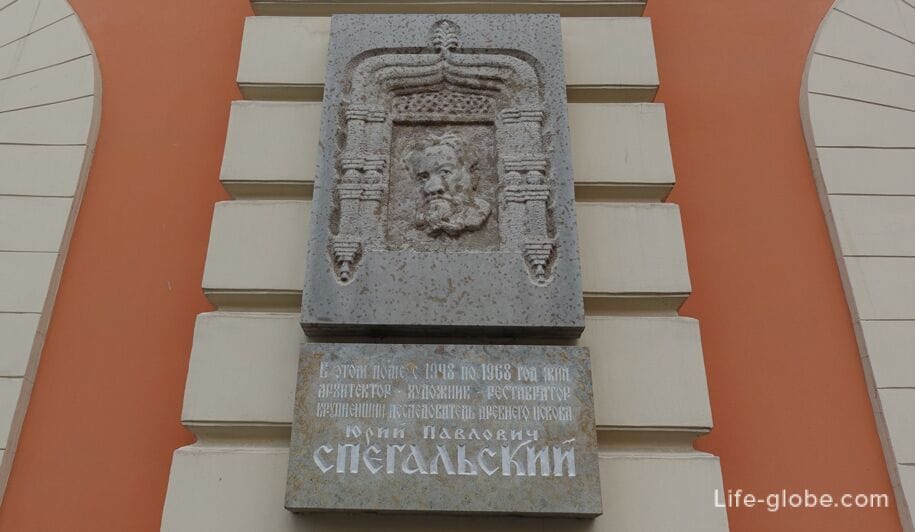
The monument to the Policeman in October 2021 was dismantled from Malaya Konyushennaya and installed near the building of the Main Directorate of the Criminal Investigation Department of the Ministry of Internal Affairs at the corner of Suvorovsky Prospekt and Kavalergardskaya Street in St. Petersburg.
On Malaya Sadovaya Street, near house No. 2, at the building on Shvedsky Lane 2, there is a monument to the policeman.
The monument was erected in 1998. The work of A.S. Charkin. The installation of the monument was associated with the 200th anniversary of the Ministry of Internal Affairs of Russia and the upcoming 300th anniversary of the city. It was assumed that the monument would be placed in this place temporarily, but in the end it remained on Malaya Konyushennaya Street.
Policeman - the lowest rank of the police guard in the capital, provincial and county cities (city police) European Russia, as well as in those non-county towns, townships and towns that have their own separate police from the county, in the Russian Empire, from 1862 to 1917.
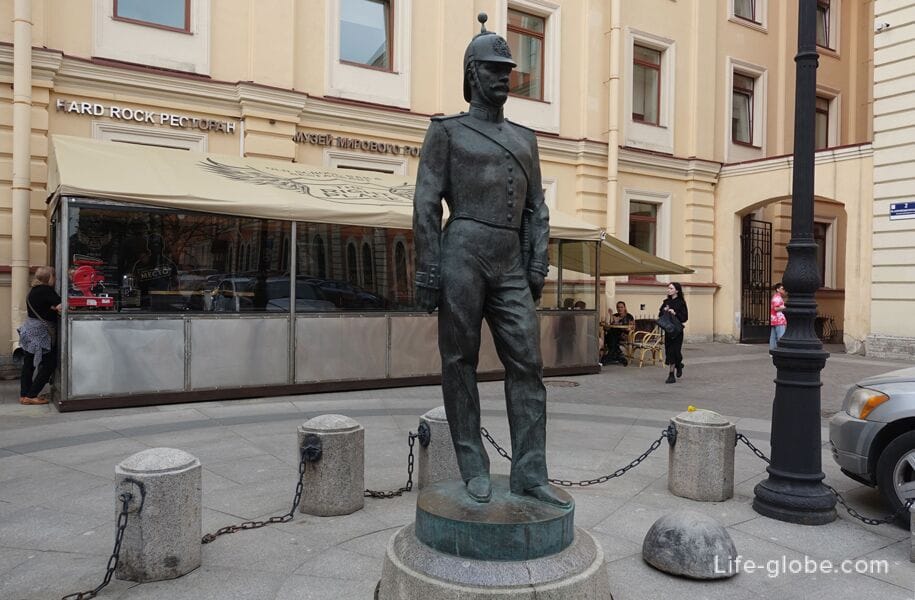
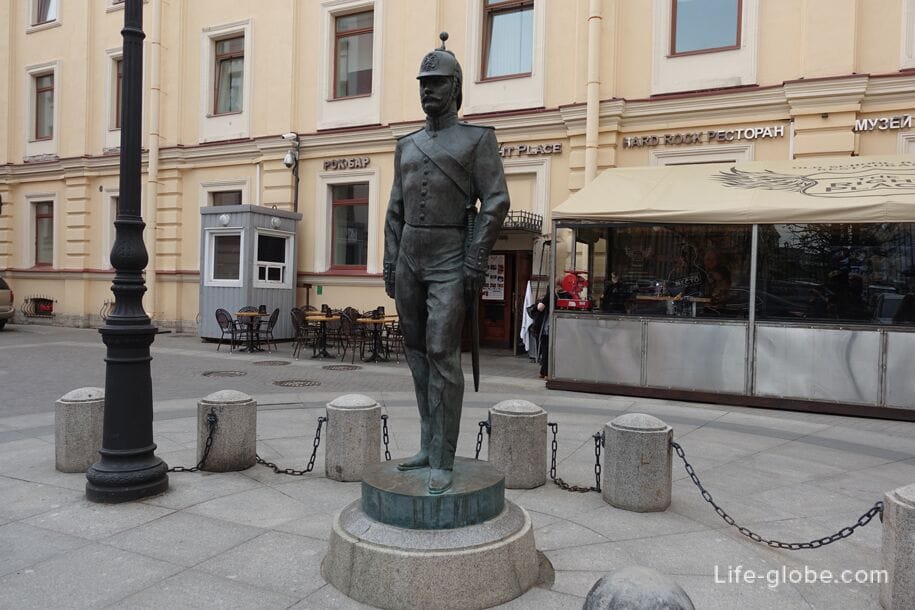
Behind the monument to the policeman is the former building of the Court and Stable Department (Swedish lane, 2).
The building was built in the 1800s by architect Rusca Luigi.
It has a classicism style.
In the walls of the building there are, among others, the One's Mind art gallery and the Doctrina et Nobiles educational center; in the wings at the address: Konyushennaya Square, 2 - the museum of retro cars of the Hollywood Auto Legend Route 66 and the museum of Soviet slot machines.
Coordinates of Malaya Konyushennaya Street: 59°56'14.0"N 30°19'31.0"E (59.937222, 30.325278).
Nearest metro stations: "Admiralteyskaya", "Nevsky Prospekt" and "Gostiny Dvor".
All accommodation facilities in St. Petersburg, including in the city center and more remotely from it, can be viewed and booked here